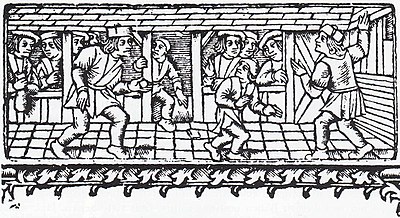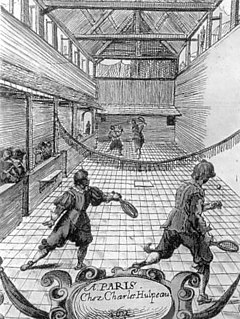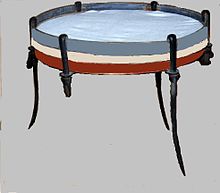Games of gain-ground/History
|
Games of gain-ground
|
Longue paumeeditLongue paume was very practised by the Middle Ages to the XVIII century in France and in Europe.
Balls also evolved because at the beginning balls were made by pressed rags on which we wound into a ball sons, the whole was covered with leather. We then used a rubber pit(core) then finally we arrive at the ball of cork covered with flannelette of a diameter from 5,5 to 6 cm and which weighs from 16 to 20 g. The ideal weight is 18 g for the been in hiding parts(parties) and of 16 g for the removed parts. Now, balls consist of three pieces of cork (a central part and two skullcaps) and of a flannelette in two pieces sewn with a single sewing. Pierre de Coubertin adhered in 1890 to the Society of Longue paume of Paris. In 1892, the Bouclier de Brennus (Shield of Brennus) is realized by the Parisian engraver Charles Brennus further to a proposal of Pierre de Coubertin to reward the winners of the championships of Longue paume in "parties terrées" and the winners of Rugby. The champions of France both federations thus receive different shield but with the same name.
During the Olympics of 1900 in Paris, a test of Long outdoor palm took place with the sporting status of demonstration. The competition took place in the Garden of the Luxembourg but there were only French teams. We played parts to be in hiding and parts to be removed. The participants were classified into two categories of levels. A competition in Courte paume was also planned in the Jeu de paume of the Tuileries but it did not take place for lack of participants. In 1908 in London, the Longue Paume was Olympic sport: the American Jay Gould takes away(gains) the tournament by beating in finale Eustace Miles (6-5, 6-4, 6-4). At the moment, the longue paume is still practised in Picardy, more particularly in the east of the Somme and the North of the Oise as well as in Paris, in the Garden of the Luxembourg. Courte paume, Jeu de paume or Real tenniseditOriginally spelled jeu de paulme, now this game is called real tennis , court tennis (US) or courte paume (France). Jeu de paume (English: "palm game") is a ball-and-court game that originated in France. It was an indoor precursor of tennis played without racquets. The term "tennis" is thought to derive from the French word " tenez ", which means "take heed" – a warning from the server to the receiver.
By the 16th century, the glove had become a racquet, the game had moved to an enclosed playing area, and the rules had stabilized. Jeu de paume spread across Europe, with the Papal Legate reporting in 1596 that there were 250 courts in Paris alone, near the peak of its popularity in France. Royal interest in England began with Henry V (reigned 1413–22) but it was Henry VIII (reigned 1509–47) who made the biggest impact as a young monarch, playing the game with gusto at Hampton Court on a court he had built in 1530 and on several other courts in his palaces. His second wife Anne Boleyn was watching a game of jeu de paume when she was arrested and it is believed that Henry was playing when the news was brought to him of her execution. Queen Elizabeth I was a keen spectator of the game. During the reign of James I (1603–25), there were 14 courts in London. In France, François I (1515–47) was an enthusiastic player and promoter of real tennis, building courts and encouraging play among both courtiers and commoners. His successor, Henry II (1547–59), was also an excellent player and continued the royal French tradition. Two French kings died from tennis-related episodes – Louis X of a severe chill after playing and Charles VIII after striking his head on the lintel of a door leading to the court in Amboise. King Charles IX granted a constitution to the Corporation of Tennis Professionals in 1571, creating a career for the " maître paumiers " and, establishing three levels of professionals – apprentice, associate, and master. The first codification of the rules of real tennis was written by a professional named Forbet and published in 1599. The game thrived among the 17th-century nobility in France, Spain, Italy, the Netherlands, and the Habsburg Empire, but suffered under English Puritanism, as it was heavily associated with gambling. By the Age of Napoleon, the royal families of Europe were besieged and real tennis, a court game, was largely abandoned. During the 18th century and early 19th century, as real tennis declined, new racquets sports emerged in England: rackets and squash racquets. In Victorian England, real tennis had a revival, but broad public interest later shifted to the new, much less difficult outdoor game of lawn tennis, which soon became the more popular sport, and was played by both genders (real tennis players were almost exclusively male). Real tennis courts were built in Hobart, Australia (1875) and in the United States, starting in 1876 in Boston, and in New York in 1890, and later at athletic clubs in several other cities.
Real tennis has the longest line of consecutive world champions of any sport in the world, dating from 1760. Ballon au poingedit
Balle à la maineditIt is a very old picard sport. Before World War II, there were about fifty societies of paume at the naked hand in Picardy. In 2008, the Fédération Française de Balle à la Main had approximately 200 graduates in Picardy distributed in about fifteen societies. 
Balle au tamiseditDocuments of the XV century point out that this game was practiced in Île-de-France, in Normandy and in Picardie. La Fédération Internationale du jeu de Petite Balle (FIPB) was created in 1900. Balle peloteeditLlargueseditLlargues is the oldest Valencian pilota modality. This game is played in the streets. Handball International ChampionshipseditIn September, 2012, the Internacional Ball Sport Federation ( C.I.J.B - Confédération International des Jeux de Balle ) decided to create 4 modalities of ball game in international competitions:
Llargues is a game of gain-ground. These games were created so that players from similar sports could play with some minimal changes in their respective rules by the International Ball game Confederation. In the first instance, it was made by European federations of different and until then isolated sports:
Later on, some countries from the Americas joined:
Old Balle au tambourineditIt is a ball game practised in Languedoc since the middle of the XVIth century. At that time, this game was played with wooden armbands ( brassards en bois in French ). In 1861, the first tambourines (wooden circle on which is stretched out a given a parchment finish skin) were used. Before 1955 in France, the Ball with tambourine ( Balle au tambourin in French ) was a game of gain-ground but in 1955, the French players adopt the Italian rules says of " open game " ( Gioco del tamburello in Italian ). This was done to allow meetings between France and Italy. With this new rules, the Balle au tambourin abandoned the notion of "chasse" and is not anymore at the moment a game of gain-ground as previously.
|
Notesedit
|












